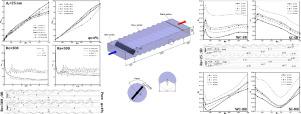Chemical Engineering and Processing: Process Intensification ( IF 3.8 ) Pub Date : 2022-07-26 , DOI: 10.1016/j.cep.2022.109072 Mohamad Hamed Hekmat , Saleh Saharkhiz

|
Heat transfer characteristics of Al2O3-water nanofluid inside a corrugated channel with a flat blade were investigated. In total, 380 simulations were performed to study the simultaneous effects of the blade's status (stationary or oscillating) and the channel wall's geometry (straight or corrugated) on thermal-hydraulic performance at different Reynolds numbers (25-500), nanoparticle volume fractions (0-4%) and diameters (25-100 nm). The results indicated that, at high Reynolds numbers, using a stationary/oscillating blade could significantly enhance thermal performance of the corrugated channel compared to the straight one. In both straight and corrugated channels with/without stationary/oscillating blade, the overall Nusselt number increased with increasing the volume fraction and decreasing the nanoparticle diameter. Examining thermal-hydraulic performance index (PI) showed a critical Reynolds number could be detected in the presence of stationary and oscillating blades, at which PI was the maximum and minimum, respectively. Accordingly, activating the oscillating blade at high Reynolds numbers and inactivating the blade at low Reynolds numbers could significantly improve PI. Moreover, PI of both channels, with/without stationary/oscillating blades, was improved with decreasing the volume fraction and increasing the nanoparticle diameter. Although PI had lower sensitivity to the nanoparticle diameter than the volume fraction, increasing the volume fraction increased this sensitivity.
中文翻译:

纳米流体流动对振荡叶片波纹通道传热强化的影响
Al 2 O 3的传热特性研究了带有扁平刀片的波纹通道内的水纳米流体。总共进行了 380 次模拟,以研究叶片状态(静止或摆动)和通道壁几何形状(直线或波纹)在不同雷诺数 (25-500)、纳米颗粒体积分数 ( 0-4%) 和直径 (25-100 nm)。结果表明,在高雷诺数下,与直通道相比,使用固定/摆动叶片可以显着提高波纹通道的热性能。在带有/不带有固定/摆动刀片的直通道和波纹通道中,总努塞尔数随着体积分数的增加和纳米颗粒直径的减小而增加。检查热工水力性能指数 (PI) 表明,在存在固定叶片和摆动叶片的情况下可以检测到临界雷诺数,此时 PI 分别为最大值和最小值。因此,在高雷诺数下激活摆动叶片并在低雷诺数下停用叶片可以显着提高 PI。此外,随着体积分数的降低和纳米颗粒直径的增加,两个通道的 PI(有/没有固定/振荡叶片)都得到了改善。尽管 PI 对纳米颗粒直径的敏感性低于体积分数,但增加体积分数会增加这种敏感性。在高雷诺数下激活摆动叶片并在低雷诺数下停用叶片可以显着提高 PI。此外,随着体积分数的降低和纳米颗粒直径的增加,两个通道的 PI(有/没有固定/振荡叶片)都得到了改善。尽管 PI 对纳米颗粒直径的敏感性低于体积分数,但增加体积分数会增加这种敏感性。在高雷诺数下激活摆动叶片并在低雷诺数下停用叶片可以显着提高 PI。此外,随着体积分数的降低和纳米颗粒直径的增加,两个通道的 PI(有/没有固定/振荡叶片)都得到了改善。尽管 PI 对纳米颗粒直径的敏感性低于体积分数,但增加体积分数会增加这种敏感性。











































 京公网安备 11010802027423号
京公网安备 11010802027423号